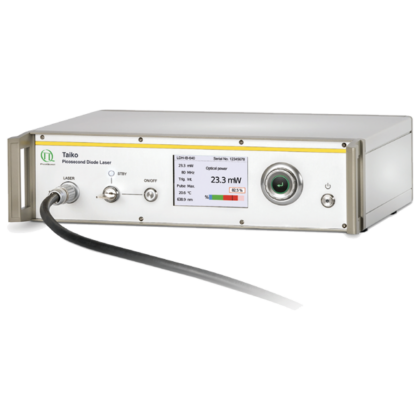Multichannel picosecond diode laser driver
- Modular system, drives up to 8 lasers or LED heads
- Adjustable repetition rates from single shot to 80 MHz or CW operation
- Computer controlled through USB
- Various operation modes: bursts, simultaneous, delayed, sequential, burst sequence
- Pulse energy control of attached laser or LED heads
- Synchronisation output, two gating options (fast/slow gate)
- Suited for LDH Series, LDH-FA Series and PLS Series
The PDL 828 “Sepia II” is a high-end, multichannel driver for the picosecond pulsed laser diode heads of the LDH Series and LDH-FA Series as well as for the sub-nanosecond pulsed LEDs of the PLS Series. Wavelength changes are simply performed by plugging in a different laser or LED head. The high quality and reliability of the PDL 828 is expressed by a unique 5-year limited warranty.
Ultra flexible driver solution
Screenshot of the operation software of the PDL 828 The PDL 828 “Sepia II” provides maximum flexibility for multiple wavelengths applications. It drives any combination of up to eight laser or LED heads in parallel or in a user defined sequence. The whole system has no manual controls – instead it is easily configured and controlled through a dedicated Windows control software via a USB connection. Last settings are saved inside the PDL 828 to allow stand-alone operation, making it a powerful device for measurement automation. A computer library to access the functions of the PDL 828 for custom development is also provided with the device.
Individual modular assembly
The PDL 828 is available in different sizes to control any number of laser / LED heads between 2 and 8 at the same time. Each PDL 828 is assembled individually from a mainframe with power supply and computer interface and two modules: an oscillator and burst generator module and up to eight laser driver modules. The communication between the modules is achieved via external cabling – delays can thus be easily inserted by using different cable lengths. The PDL 828 allows to produce a wide range of user-definable pulse patters such as sequences or bursts. All connected laser/LED heads can also be fired at the same time.
Powerful oscillator module
PDL 828 in a small configurationTwo models of oscillator and burst generator modules are available, each with eight individually addressable trigger outputs (output channels). Both modules feature a rotary sequencer with programmable channels where one channel must be completed before the next one activates.
The SOM 828 module allows grouping of adjacent output channels so that they can be activated at the same time. The 8 channels of the SOM 828-D module can be freely combined with each other to yield complex pulse patterns where one channel will activate simultaneously with its combination partners. Alternatively, instead of combining channels, an individual, software controlled delay can be introduced for any non-combined channel.
Both modules offer burst operation, where multiple pulses can be output from either single, grouped, or combined channels before the next channel becomes active. Both oscillator modules have their own (variable) synchronization output, external trigger input as well as auxiliary input and output connectors.
Flexible laser driver module
A laser driver module is necessary for each laser/LED head that needs to be connected and controlled at the same time by the PDL 828. The timing of the emitted pulses can be controlled by an external trigger signal, which is typically provided by the oscillator module or any other source providing a NIM compatible signal. As a special feature, each Laser Driver Module can also operate independently from the other modules driven by its internal low-jitter oscillator at six fixed, user-selectable frequencies (80, 40, 20, 10, 5 or 2.5 MHz). All emitted laser pulses are accompanied by a synchronization output at the front panel of the laser driver module. This signal is always synchronised to the trigger source, independent from the selection of triggering mode (i.e., external or internal triggering).
Complete control of laser power and CW operation
The intensity of the laser emission is controlled via an internal voltage in steps of 0.1% of its full scale value. However, due to the non-linear behaviour of laser diodes, the voltage setting does not linearly correspond to the output power, i.e., a voltage of 50% does not correspond to 50% of the maximum output power. A special feature of the PDL 828 is to switch between CW and pulsed mode with the LDH-D Series of laser heads.
Gating options
For special applications using, e.g., scanning devices, the PDL 828 provides two special gating options that allow to suppress the laser emission by an external signal: A slow gate, that reduces setting times of the laser heads to a minimum at slow on / off periods (seconds) and a fast gate, that can perform transitions within nanoseconds, i.e., in between two pulses. The fast gate also provides high pulse stability when the on/off signal is periodic and fast (milliseconds).
For applications that require only a single wavelength, the alternative single channel driver PDL 800-D can be provided.



































